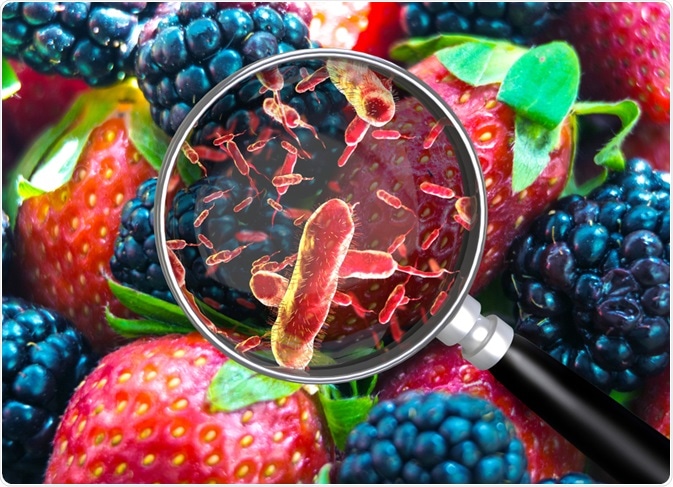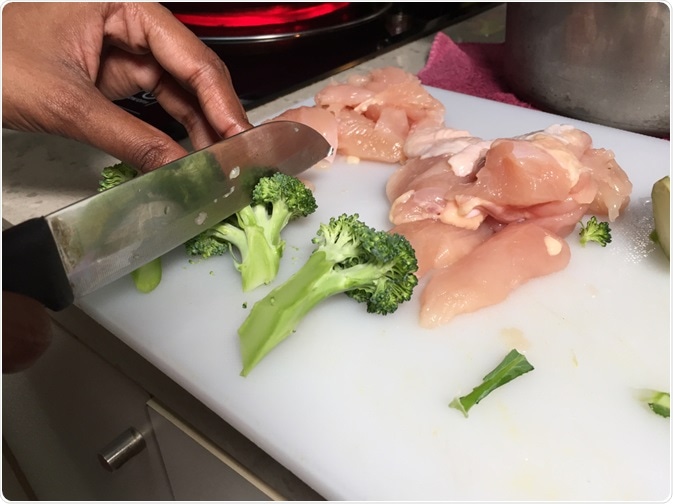More than 200 diseases, from diarrhea to cancer, are associated with food contamination. Bacteria, viruses, parasites, and chemical substances can all be introduced into the body via contaminated food, the result of which being a huge burden to public health.

Contaminated Food. Image Credit: Giovanni Cancemi/Shutterstock.com
With around 1 in 10 people around the world falling ill each year from consuming contaminated food, and roughly 420,000 million of these cases ending in death, the issue of food safety has become a public health priority.
Here, we discuss the nature of food contamination, the various bacteria, viruses, parasites, and chemical substances that contaminate food, and the four main routes contributing to food contamination. Finally, we discuss what is being done to prevent food contamination to protect human health.
The nature of food contamination and its impact on health
Food can become contaminated with a variety of bacteria, viruses, parasites, and chemicals, the effects of which can range from mild food poisoning to disease and death.
Campylobacter, Enterohaemorrhagic Escherichia coli and salmonella are some of the most common types of foodborne pathogens that contaminate food. Millions of people come into contact with these pathogens each year, the outcome of which can be fatal. In addition, listeria contamination, another common pathogen, can cause miscarriage and death in newborns. In terms of viruses, norovirus and hepatitis A can be transmitted via food, with serious health consequences.
Parasites can also contaminate food and lead to illness. Fish-borne trematodes, tapeworms such as Echinococcus spp, or Taenia solium, and other parasites such as Ascaris, Cryptosporidium, Entamoeba histolytica, or Giardia, are among the most common. Additionally, prions, a class of infectious agents built of a protein, can also contaminate food, causing serious health problems to those consuming infected food. Bovine spongiform encephalopathy, known as BSE, or "mad cow disease is a prion disease that can be transmitted via contaminated meat, causing the variant Creutzfeldt-Jakob Disease (vCJD) in humans.
Finally, chemicals can also be unwillingly introduced to food products. Naturally occurring toxins such as mycotoxins, marine biotoxins, and cyanogenic glycosides can contaminate food, causing cancer and disrupting immune function. Persistent organic pollutants (POPs) which accumulate in the environment, such as dioxins and polychlorinated biphenyls (PCBs), can also cause cancer and damage to the immune system when ingested. Heavy metals are the final group of chemicals that commonly contaminate foods, such contamination can lead to neurological and kidney damage.
Main routes to contamination
There are four main routes to food contamination: cross-contamination, improper hand washing, inappropriate storage and temperatures, and contamination by animal waste.

Cross Contamination. Image Credit: kathrinerajalingam/Shutterstock.com
Cross-contamination is the transference of harmful bacteria from one source to another. In food, it occurs when food pathogens are transferred from one food item to another via shared surfaces, cooking utensils, or any items that come into contact with the infected food item and then another. The biggest threat is posed by raw food products which can carry pathogens that are destroyed when cooked but can spread to other items while they are raw. Using separate chopping boards and knives for preparing high-risk foods such as raw meat, as well as keeping cooked food away from raw food can prevent cross-contamination and re-contamination. Studies have also shown that keeping food preparation surfaces dry can prevent bacterial growth.
Improper handwashing can transfer pathogens to food from infected humans who handle the food. Commonly, food contaminated in this way is exposed to trace amounts of fecal matter on the hands which carry the harmful pathogens. Studies have shown that regular, thorough hand washing is an effective preventative method at reducing this kind of contamination route.
Inappropriate storage and maintaining and cooking food at incorrect temperatures is another key route to food contamination. Storing food at cold temperatures, via refrigeration or freezing, prevents almost all kinds of bacteria from growing. On the other hand, cooking food sufficiently is effective at killing off many bacteria, parasites, and viruses. Additionally, food that is not stored appropriately in terms of separating cooked from raw foods, particularly meat, and keeping raw meats at the bottom of the fridge to ensure drippings do not contact other food is vital for preventing this kind of food contamination.
Finally, food can also be contaminated by animal waste. A wide range of foodborne microbes exist in healthy animals that are raised as livestock. During the slaughter process, meat and poultry can become contaminated by very small amounts of contents that originate in the animals’ intestines. Another route to contamination of food with animal waste is improper washing of fresh fruits and vegetables. In some parts of the world, there is a greater risk that the water used to wash fresh produce may have been contaminated by animal manure or human sewage.
While there are numerous routes to food contamination, which can cause serious health implications and even death, scientists are continuing to study the nature of contamination and develop strategies to avoid it - strategies that are often simple and require only education about proper food preparation and cooking methods.
Sources:
- Carrasco, E., Morales-Rueda, A. and García-Gimeno, R., 2012. Cross-contamination and recontamination by Salmonella in foods: A review. Food Research International, 45(2), pp.545-556. www.sciencedirect.com/science/article/abs/pii/S0963996911006260
- Food safety. World Health Organization. Available at: https://www.who.int/news-room/fact-sheets/detail/food-safety
- Green, L., Selman, C., Radke, V., Ripley, D., Mack, J., Reimann, D., Stigger, T., Motsinger, M. and Bushnell, L., 2006. Food Worker Hand Washing Practices: An Observation Study. Journal of Food Protection, 69(10), pp.2417-2423. meridian.allenpress.com/.../Food-Worker-Hand-Washing-Practices-An-Observation
- Kusumaningrum, H., 2003. Survival of foodborne pathogens on stainless steel surfaces and cross-contamination to foods. International Journal of Food Microbiology, 85(3), pp.227-236. www.sciencedirect.com/science/article/abs/pii/S0168160502005408
Further Reading
Last Updated: May 14, 2021